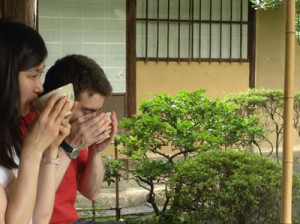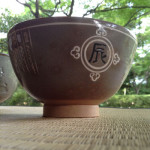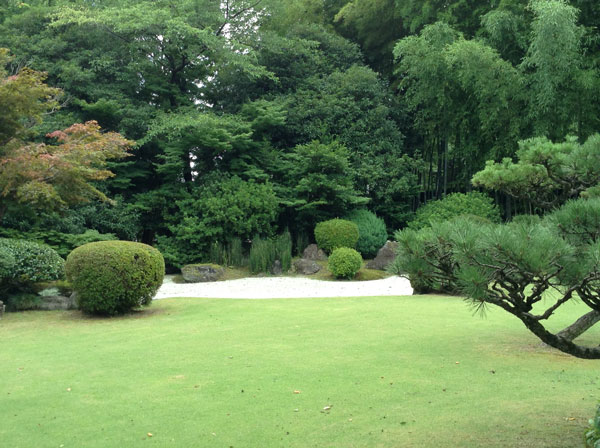My Personal Experience of Urakuen Japanese Garden
 Soon after strolling halfway through the verdant garden of Urakuen, I was savoring a bowl of matcha tea less than a dozen feet from the precious teahouse named Jo-an. I was immersed in an environment that evokes the age of the samurai and the birth of the refined Japanese tea ceremony. Drinking tea in Urakuen, is as close as possible to having the same experience with tea that warriors, Zen monks, artists, politicians, and elite merchants did hundreds of years ago.
Soon after strolling halfway through the verdant garden of Urakuen, I was savoring a bowl of matcha tea less than a dozen feet from the precious teahouse named Jo-an. I was immersed in an environment that evokes the age of the samurai and the birth of the refined Japanese tea ceremony. Drinking tea in Urakuen, is as close as possible to having the same experience with tea that warriors, Zen monks, artists, politicians, and elite merchants did hundreds of years ago.
In front of me, sunlight silently slipped through treetops and dappled carpets of hairy moss. Bird cries and fluttering bird wings burst through the silence, then subsided. My Japanese brother-in-law, who is usually exhausted because he often works twelve hours each workday, was sitting on the smooth wooden veranda to my left, calmly fanning himself and smiling. The surroundings were soothing his troubles away.
 The soft padding of bare feet on tatami flooring behind us announced the arrival of the sugary wagashi (traditional Japanese sweets) that the Japanese customarily nibble before contemplating and drinking the matcha tea served at teahouses. A smiling, gentle lady with a touch of grey in her hair approached and fluidly kneeled on the floor with a plate of wagashi in each hand. She placed the sweets in front of us and in keigo, the most polite register of Japanese (an important aspect of chado is showing respect and consideration), suggested that we eat.
The soft padding of bare feet on tatami flooring behind us announced the arrival of the sugary wagashi (traditional Japanese sweets) that the Japanese customarily nibble before contemplating and drinking the matcha tea served at teahouses. A smiling, gentle lady with a touch of grey in her hair approached and fluidly kneeled on the floor with a plate of wagashi in each hand. She placed the sweets in front of us and in keigo, the most polite register of Japanese (an important aspect of chado is showing respect and consideration), suggested that we eat.
The gelatinous, translucent outside layer was made from the powdered leaves of the kudzu plant (the invasive plant from Japan that is spreading wildly across much of the U.S.). Inside was a soft ball of Ankou, creamy sweetened red beans. The wagashi came with a specialized single chopstick (called kuromoji), that had been hand carved from the branch of an aromatic bush, called spicewood (Lindera umbelatta).
I cut the sweet with the kuromoji, speared the slice with the tip, and carried the tasty morsel to my mouth, where the slight scent of the oil in the wood combined with the taste of the kuromoji. I felt that the Japanese way of tea is both sensuous and spiritual.
Our host gracefully stood in an effortless motion and slipped out of the room, leaving us alone with our sweets, our thoughts, and the garden view. We nibbled slowly. Somewhere in the distance, on the other side of a thick verdant hedge, I heard the faint clicking serenade of the first cicada of the humid summer afternoon.
Soon afterward, the kind lady returned with two bowls of freshly stirred, slightly foamy, green tea in bowls without handles. At teahouses, Japanese drink matcha from a bowl, called a chawan. Holding the bowls with both hands as we brought them to our mouths, we tipped our heads upwards and the delicious elixir slipped over our tongues.
Just as we were finishing our tea, a young couple, Kaorie from Hokkaido and Kristin from France, joined us on the veranda, where we chatted about tea. Kaorie said she had never been in such a perfect environment for drinking Japanese tea as the garden in front of us.
 Kirstin reported that in France, green tea is experiencing a boom. In fact, French make up the largest group of foreign visitors to Urakuen. After his first taste of the green tea, Kirstin exclaimed that the flavor and texture of the tea was different than any he had ever drunk in France. “It was really good!” he concluded.
Kirstin reported that in France, green tea is experiencing a boom. In fact, French make up the largest group of foreign visitors to Urakuen. After his first taste of the green tea, Kirstin exclaimed that the flavor and texture of the tea was different than any he had ever drunk in France. “It was really good!” he concluded.
In harmony with Jo-an’s birthplace, the tea was from Kyoto. The brand’s name is Shonzuinomukashi, which means “good omen from the past.” I noticed that the verdant tea color matched some of the leaves in the garden. The texture was creamy, and a vegetal sweetness lingered in the mouth after swallowing.
Completely reinvigorated by the tea and atmosphere, my brother-in-law and I bid our new tea friends goodbye and strolled outside to see more of Urakuen.







